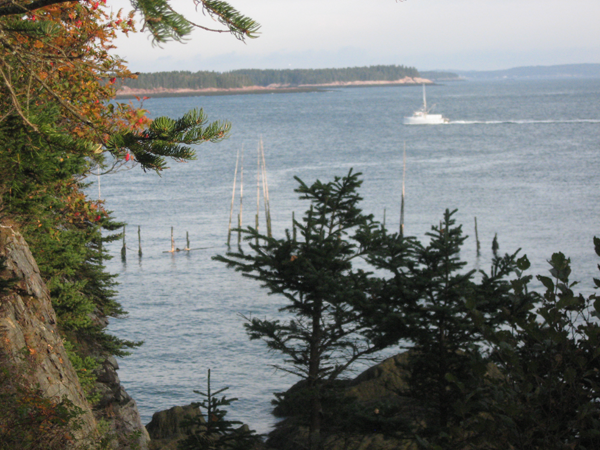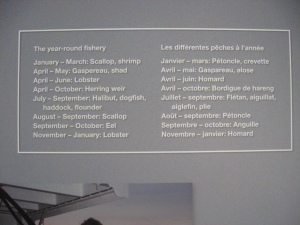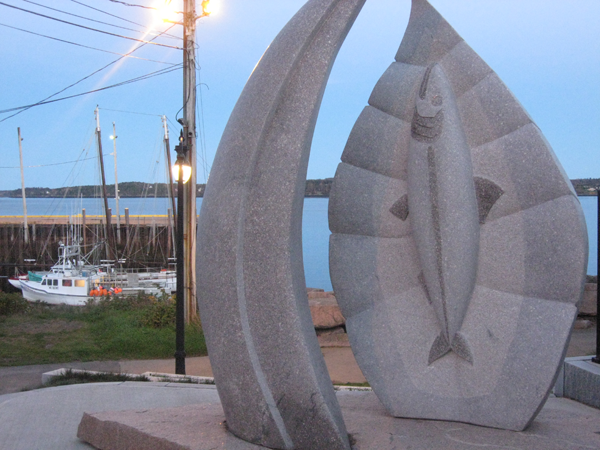
How the Two Nation Vacation is All About the Fish

by Natalie Springuel
Recently, about 20 tourism industry leaders from Downeast Maine and Southwest New Brunswick piled into a bus and went on a tour of the region. For nearly four days, we traveled from Saint John New Brunswick to Bucksport Maine, on a world wind tour of the target area of the Two Nation Vacation.
Catchy moniker, isn’t it?
The Two Nation Vacation is the joint brainchild of Maine’s Office of Tourism and New Brunswick’s Department of Tourism, Heritage and Culture. The idea is to entice tourists to extend their travels, get off the beaten path, and even cross the border, in the hopes of course of growing a bit of local economic return.
Being the coordinator of the Downeast Fisheries Trail was my ticket to going on this little trip. In tourism speak, this was a “fam” tour, or familiarization tour, where you travel in the company of people from all sorts of different businesses, organizations, and initiatives. You stop at more places per day than any tourist would reasonably visit, and get a behind the scenes look at many of the incredible offerings of the region’s tourism industry. By the end, if the tour was successful, you and your travel mates are scheming all sorts of community development ideas and you have reams of fodder for marketing and generating enthusiasm about this REALLY COOL PLACE that you just experienced.
Experience is the key word here. There is so much to experience in the Two Nation Vacation region. And for me, an extension association with Maine Sea Grant, I was constantly on the lookout for anything having to do with fisheries, aquaculture, and maritime heritage, anything that would help travelers connect with the Gulf of Maine, the ocean, the working waterfront, and how people have made a living on this sea for generations. I was looking too for experiences that enable tourists to connect with the present as much as the past, highlighting today’s generation of fishermen, fish farmers, mariners of all types, and the products that come from the sea, now.
I wasn’t disappointed. We live and work in one of those places on the planet where you can still get really close to the natural resources, were you can smell, see, and touch the ocean, you can taste its fruits, and you can feel the passion in the voice of the locals who make a living here.
Some stories worth sharing:
Sturgeon caviar. The Saint John River in New Brunswick is home to sturgeon, that elusive prehistoric fish listed as endangered in the US and vulnerable in Canada. A couple of New Brunswick aquaculture firms are growing sturgeon in captivity for the production of caviar, enabling travelers to sample the native species without contributing to its further decline. Neat.
Salmon guts on roses. Wait, let me explain. Kinsbrae Garden in St. Andrews, New Brunswick, uses a fermented salmon spray on their rose bushes. Nothing, they say, keeps the mildew down like the salmon guts. What a cool factoid for visitors to learn regarding the salmon farming industry.
Dulse chips. No trip to the Bay of Fundy, New Burnswick, is complete without a sampling of dulse chips. Dulse is that red leafy seaweed that grows in the lower intertidal zone all over this region, and Grand Manan Islanders have long had a corner on this natural salty snack market.
Mustard. Lots and lots of mustard. Raye’s Mustard in Eastport, Maine, is the last cold pressed mustard mill anywhere in North America! Why is it here? Because mustard is a fantastic condiment used to preserve and flavor tinned sardines. Many coastal villages in our region once housed sardine factories and Rayes Liquid Gold was everyone’s favorite. Now they call it gourmet and it sells. Again, what a cool way to help visitors connect to fisheries heritage.
Turning tragedy to comedy. When we stopped in at Rayes, it was a week before Halloween. Dozens of “RIP” cemetery headstones were leaned against the wall, in preparation for the Halloween Festival.Each headstone had the name of a sardine factory. RIP indeed, because the sardine industry is done, completely gone on the US side of the border. There is no other word but tragedy to explain it. But the legacy of these little fish (Atlantic herring) lives on in communities throughout the region, some with humorous twists and colorful headstones.

Fishy art: On the Eastport waterfront, a granite sculpture (part of the Schoodic Granite Sculpture Symposium) depicts a couple sardines – there they are again – standing tall against the backdrop of the sea, alongside a sail. The bold and graceful sculpture stands near the huge caricature of a fishermen, another sculpture, this one erected a few years ago by a film crew who left it behind for the town and its visitors.
I could go on and on with these vignettes (and maybe I will in future blogs)…
The bottom line is that visitors to this area simply couldn’t get away from the fisheries connections even if they wanted to! But why would they? A truly wonderful travel experience, so the travel market data tells us, is one made of real live experiences that connect us to the people who live and work in wonderful places. We’ve got all of that in our region right here: Downeast Maine, the Fundy Isles, Southwest New Brunswick. This chunk of land on the rocky coast of North America, despite that political line separating it in two, is brewing into something worth checking out as one unified region. And the people doing the brewing are some creative!
Now what was that about a successful fam tour leading to all sorts of nifty ideas for future projects? Tour participants (about 10 from each side of the border) have already been talking about ways to share their ideas and work. Until then, you’ll just have to sit tight and stay tuned for future updates and more cool stories about how the Two Nation Vacation really is all about the fish.
